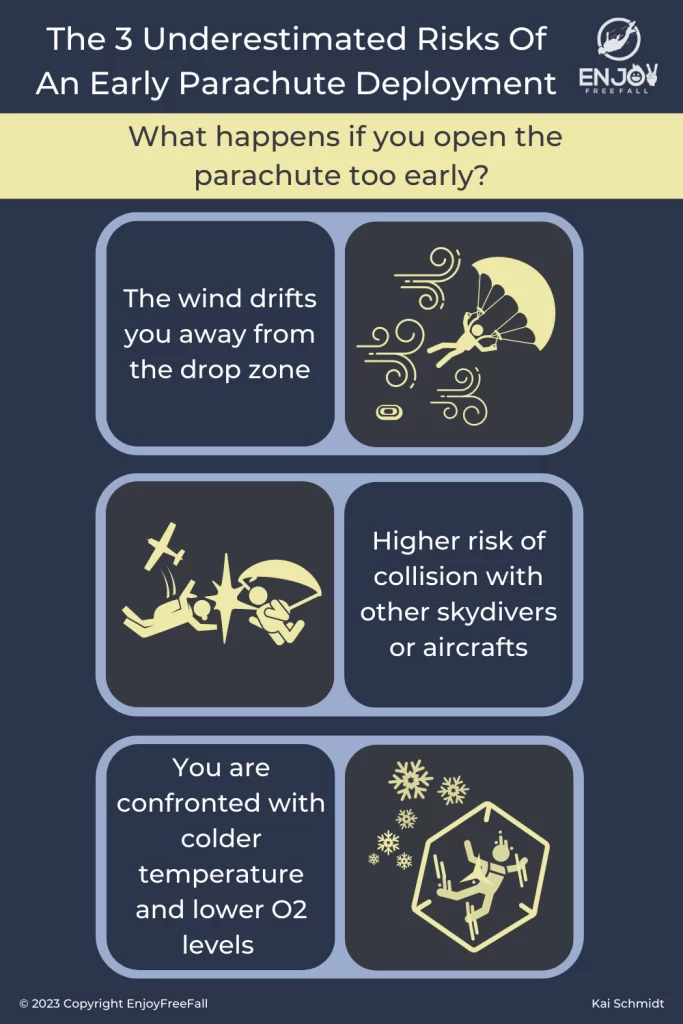
Everyone knows that opening a parachute too low can result in extreme injuries for skydivers. However, have you ever asked yourself about the opposite? About what happens if the skydiver opens the parachute too early?
While opening the parachute too early will not prevent the parachute from opening, it can be still dangerous due to the following problems:
- The wind drifts the skydiver away from the drop zone
- There is a higher risk of collision with other skydivers or aircrafts
- The skydiver is confronted with colder temperatures and lower oxygen levels
Although it might not sound risky to deploy the parachute too early, a high percentage of skydiving accidents happen due to early parachute deployment. In general, too early parachute deployment refers to the case where the skydiver either opens the parachute unintentionally above his planned deployment height or at an altitude that he is not properly prepared for.
The Wind Drifts The Skydiver When Opening The Parachute Too Early
The Risk Of Strong Wind
In general, the wind is much stronger in the sky than at the ground and increases quite strongly with increasing altitude. For example, the wind can be 12kt (14 mph, 22km/h) at 2,000ft (600m) while being 26kt (30 mph, 48km/h) at 5,000ft (1,500m) and 38kt (44mph, 70km/h) at 14,000ft (4,200m).
Not only is it more difficult to control the canopy in stronger wind, there is a higher risk of eddies, vertical currents and down draughts that do not affect skydivers during the freefall but do so when the parachute is inflated. A vertical current can throw the skydiver around and result in parachute malfunctions, spiraling canopies and line entanglements.
Skydivers normally deploy their parachutes somewhere between 2,500 to 4,000ft, which means that they will check the wind forecast for that height and pick the parachute size accordingly. If they then open the parachute at 14,000ft instead of at 2,500ft, the parachute does not have the right size to navigate through the wind conditions and it becomes much harder to control the canopy.
Have you ever wondered how skydivers maneuver their bodies during freefall and safely navigate back to the ground? While it may look effortless, skydiving requires precise control and technique to achieve the desired outcomes. In this blog post, I delve into the different maneuvers skydivers use to control their movements and speed during freefall.
If the skydiver is not able to control the canopy, he can be thrown around by the wind which can result in parachute malfunctions or line entanglements. In better cases, the skydiver will be able to avoid any malfunctions, however, it will still be much harder (if not impossible) to steer the canopy properly and fly to the drop zone. (It can be a real pain to not land at the drop zone but it can also be quite dangerous).
Being unable to steer the canopy, is often more problematic for beginners as they usually have bigger canopies (as they allow for softer landings). A big canopy will capture more wind and then will accelerate to a higher speed in a strong wind which makes it much harder to steer and to go in the right direction.
Experienced skydivers often use smaller (ultra-performance) canopies so they will not be affected as much by strong wind as beginners. Nonetheless, it can still be a mentally and physically exhausting ride if the skydiver did not prepare for a high deployment height. He needs to observe his environment for other aircrafts and skydivers, navigate through the air without losing orientation and steer the canopy.
In contrast to experienced skydivers, beginners are also more likely to panic when deploying the parachute too high. The other skydivers might not realize that the beginner has deployed too early and will continue their freefall.
It happens quite fast that the beginner suddenly feels alone in the sky and does not see his fellow skydivers. If this is combined with strong winds, in which the beginner is not able to steer properly, he might panic.
And panic is usually the biggest source of human errors in skydiving. If you are interested in knowing more about the most common sources of skydiving accidents, check out this post.

Landing Apart From The Drop zone
Even though the risk of wind turbulences and strong wind is greater at a higher altitude, skydivers who deploy their parachutes early are often able to approach the ground without any major issues. It is more likely, that the skydiver will be drifted away from the drop zone and has to land in unknown territory.
Landing in unknown territory presents a great risk for the skydiver. In the worst case, the skydiver might hit some rocks, electronic fences or barbed wire which either results in injuries or death.
Are you curious about how likely you will get injured during a skydive? If yes, check out my article about the true risks of skydiving. It will give you a mind-blowing, new perspective on the sport!
In the best case, the skydiver lands safely but will be miles away from his drop zone without any idea of where he landed. This can be a real pain if you didn’t bring your smartphone or any other communication device and it can take you hours to return to the drop zone. (And people will get worried during this time!)
Those kinds of landing problems account for 15% of all skydiving fatalities and therefore pose a greater risk than parachute malfunctions.
Jumping Close To The Ocean
Opening the parachute early increases the time in the air for the skydiver. It can be really nice to have more time in the air, specifically when you can enjoy beautiful scenery close to the ocean or mountains.
However, if you want to deploy your parachute early in such settings, please make sure that you are prepared properly i.e. that you checked the wind forecast, picked the right canopy size and that you have the appropriate skill level.
The last thing that you want is that offshore wind drifts you to the ocean and forces you to land in it. It will take a long time for someone to find you and it will be hard to swim with the canopy.
Greater Risk of Collision With Other Skydivers and Airplanes When You Open The Parachute Too Early
While being exposed to stronger wind after opening the parachute too early, skydivers also face risks during the deployment process when opening the parachute too early.
Would you like to know the role of the parachute when it comes to deceleration? Read my article about how fast a parachute opens and be surprised how the deceleration differs depending on the type of jump!
Most of the early deployments happen unintentionally. As skydivers usually jump in groups there is a specific order who jumps and deploys his parachute first. If someone alters from this order, it puts himself and other skydivers at risks as they might collide. If two skydivers collide, one might be hit unconscious, the canopy might break or the lines might get entangled which often results in injuries or fatalities.
The earlier the skydiver deploys the parachute the higher the risk is of a collision due to the increased proximity of the jumpers. If the diver deploys immediately after jumping, he might also get entangled with the aircraft.
Canopy and freefall collisions account for nearly 10% of all skydiving accidents and are commonly caused by an early deployment. This risk is even greater when performing a formation stunt due to the increased proximity of the skydivers.
Unintentional early deployment can also be a problem if the skydiver does not have the right body position yet. If one opens the parachute in a head-down-to-earth or sit-flying-position, the body can get entangled with the lines and robes. This can cause the parachute to not open or can dislocate the shoulder and strangulate entangled body parts. The only upside in such cases is that the skydiver has more time to resolve the problem because he opened the parachute at a much higher altitude.
Another problem that might occur when you jump in a busy area is that the skydiver might collide with another aircraft. Because the skydiver is much longer in the air and might be drifted away from the planned flying area, other aircrafts might not be aware of him and might hit him. Although this is not overly likely, it has happened before and you most certainly want to watch out for it.
Confrontation With Lower Temperature And Oxygen Levels
Although you will not die if you are exposed to lower oxygen levels and lower temperatures, it can be quite an unpleasant experience.
Depending on the time of the year, there can be a huge temperature difference between 14,000ft (4,200m) and the usual deployment height of 2,500ft (750m). Let’s say that the skydiver dressed for 55°F at 2,500ft but then deploys the parachute at 14,000ft with a temperature of just 12°F (-11°C).
The skydiver will face a temperature difference of 75°F (24°C) which is quite a bit if you consider that he will be in the air between 15 and 20 minutes. As I said, this will not kill him, but it is a very unpleasant experience that one should try to avoid. (If it interests you the temperature drops approximately 3.5°F per 1,000ft (~2 °C per 330m)).
Similarly, the difference in oxygen level will not kill the skydiver but is likely to make him tired faster. This can affect his ability to steer the canopy and to keep his orientation up (and this might result in human errors). People only need to wear oxygen support at 20,000ft, where the effective oxygen percentage is at 9.7%. The oxygen level is 12.3% at 14,000ft and therefore still much higher than the minimum but also much lower than the 20.9% that we are used to at the ground.
In conclusion, it is not a problem to open the parachute early, when the skydiver does so intentionally and is properly prepared for it.
If you are interested to know more about the lowest possible altitude to open a parachute, check out this post. (It will also give you the current world record for the lowest opening height)
Enjoy your freefall (or your extended canopy ride)!



